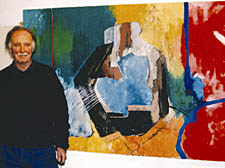|
|
 |
| |

Artist Bill Kennedy. ‘He was wholly committed to his painting’ |
The artist formerly known as doctor
Show pays tribute to abstract painter who gave up career as Great Ormond Street medic
IT was while roaming the streets on his bike that an eminent doctor from Holloway was inspired to leave a lucrative career in medicine to follow his lifelong passion for painting.
Now, artist Bill Kennedy – who died aged 85 at Whittington Hospital in Archway last year – will be celebrated at a retrospective exhibition of his work at Lauderdale House in Highgate.
The exhibition, Tell Them Billy Boy Was Here, shows his development as an abstract painter over the 40 years he worked from a studio at his Cardozo Road home.
Dr Kennedy’s widow Mary, who is staging the exhibition, chose the gallery in Waterlow Park as the 26 acres of green space inspired much of his work.
“Bill was very much influenced by his surroundings,” she said. “When our son Iain was young, he used to take him to Waterlow Park and he’d do sketches of trees and plants. Nature was a big inspiration to him.”
Born and raised in Canada, Dr Kennedy came to London in 1942 as a young soldier serving with the Black Watch regiment. A self-proclaimed Londoner, he quickly struck up a relationship with the capital that would last all his life.
“He fell in love with London,” Mary said. “He loved the stimulus and culture associated with London life.
“He was always into the arts, and used to hang out with actor friends at the Old Vic and later the National Theatre. He also loved the ballet. He was romantically taken with ballerinas – in fact, he nearly married one.”
After the war, Dr Kennedy went back to Montreal to train as a doctor. But his love affair with London continued when he returned in 1959 to work as a pediatrician at Great Ormond Street Hospital, before specialising in psychotherapy.
It was as he was about to undertake further training in psychoanalysis that the Canadian-born medic decided to follow his true passion for art.
Mary said: “I think he just stopped and thought: ‘Actually, this is not what I want to do – I just want to paint.’ He gave up medicine just like that and began working as a joiner and carpenter to pay the bills and set up a studio for his work.
“It was a big step for someone in his late 30s to give up his standing as a doctor for a career in art. But he was wholly committed to his painting.”
Mary described Dr Kennedy, a former chairman of Acland Burghley Parent Teacher Association, as “rather dour”, owing to his Scottish heritage. “He wasn’t one to flounder around telling you what was on his mind,” she said.
“He probably would have said: ‘Why bother with the exhibition?’ But secretly would have been rather delighted by it. Like many painters, he would pretend recognition was not important to him.”
|
 |
|
|
 |
| |
| |
|
 |
|